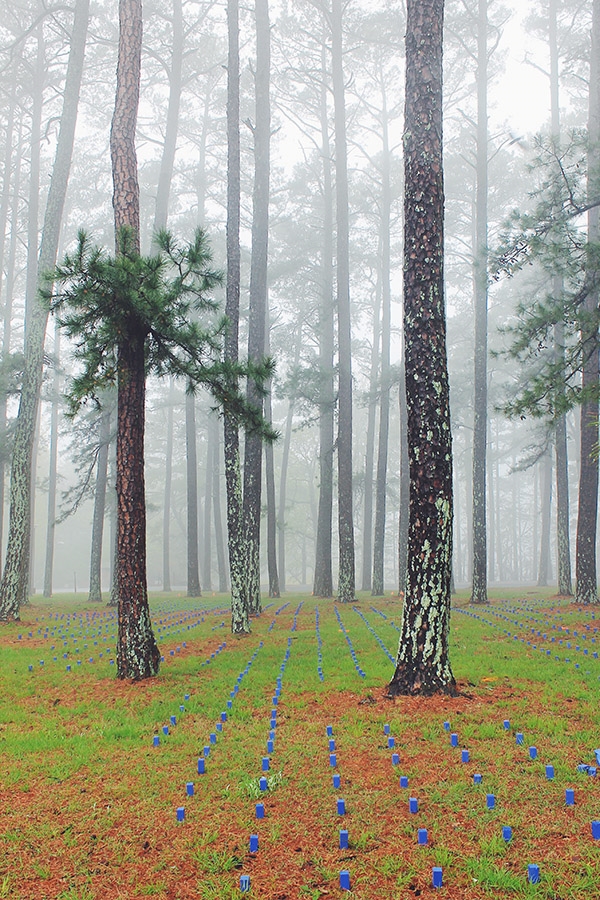
FAYETTEVILLE, Ark. — The landscape installation Visible Invisible was selected in a juried competition for exhibition at the Winthrop Rockefeller Institute in Morrilton.
Phoebe Lickwar and Laura Terry, both professors in the Fay Jones School of Architecture and Design at the University of Arkansas, collaborated as the lead designers on the project.
Visible Invisible will be unveiled Saturday, April 28, during Art in its Natural State, a daylong celebration of the arts in Arkansas featuring demonstrations, performances and interaction. The work will be installed on the institute grounds at Petit Jean Mountain and open to the public through April 2019. It was among nine temporary, outdoor artworks selected in this regional competition.
The Visible Invisible project provides an experience for visitors highlighting the ecological and cultural significance of a pine grove planted by Gov. Winthrop Rockefeller. Connections are made between what is visible — a dense plantation of shortleaf pine (Pinus echinata) — and what is invisible — the ecological connections between the trees, the endangered red-cockaded woodpecker, and all other species above and below the ground that are interconnected in networks of interdependence.
Lickwar is an associate professor of landscape architecture and principal of FORGE Landscape Architecture, and Terry is an associate professor of architecture. To realize the project, they worked with Hannah Moll, a 2017 graduate of the University of Arkansas landscape architecture program and designer at FORGE Landscape Architecture, and a team of students from the departments of architecture, interior design and landscape architecture in the Fay Jones School.
"I was excited to work with Phoebe on this project, because we share an interest in the landscape as the subject for our creative and visual research," Terry said. "The elements of landscape and how those elements interconnect inspire both of our artistic and design endeavors. Working together and finding common ground in the concept was a unique opportunity to push our ideas from two dimensions into three dimensions, from the photograph or the painting into a physical and spatial realm."
Nine tree cloaks establish a visual and temporal datum in the grove, marking the significance of these trees as potential future hosts for the red-cockaded woodpecker. A field of blue forestry survey stakes marks the expanse of the trees' root structure, defining the extent of the rhizosphere below the surface of the ground and a pathway for people through the grove.
The cloaks serve as a measure of time, a datum referencing the ultimate size of tree trunks at maturity. The red-cockaded woodpecker excavates the heartwood of shortleaf pine affected by heartwood decaying fungi, which only occurs in mature trees. If preserved as a managed stand, the trees of this grove could one day be inhabited by the birds and their associated species.
"It's our hope that this work not only creates an experience for people that strengthens their appreciation for the magical sensory qualities of the grove — the changing light raking through the canopy, the volumetric space of the vertical, regularly spaced trunks, the color and texture of bark and needles — but also alerts visitors to the extensive and complex relationships between species that comprise and inhabit the grove as an ecosystem," Lickwar said.
"We rarely consider the web of life that lies beneath our feet — or species, like the red-cockaded woodpecker, who rely upon mature forests for habitat," Lickwar continued. "We hope this work contributes to building ecological literacy by acknowledging the significance of what we cannot see, hear, or touch — the invisible, but essential aspects of the forest ecosystem."
In addition to Lickwar and Terry, the competition team for this project included Moll and Erin Cox, a fourth-year landscape architecture student. Moll also led the fabrication team of Fay Jones School students, which included Connor Angi, Kyle Beard, Caleb Bertels, Corrine Burns, Beau Burris, Erin Cox, Sydney Davis, Kate Eihausen, Callie Fleetwood, Max Frank, Ace Jerusalem, Maddie McClintlock, Dallas Meyers, Alli Preston and Danielle Yatsook.
The Fay Jones School is sponsoring the site for this installation, in recognition of the example of such collaboration and in recognition of the work of the students.
The Art in its Natural State celebration is free and open to the public.
Topics
Contacts
Michelle Parks, director of communications
Fay Jones School of Architecture and Design
479-575-4704, mparks17@uark.edu